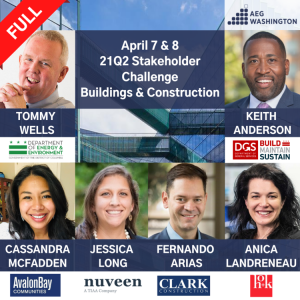Overview
 The Building Innovation Hub (the Hub) recently participated in the 2021 Quarter 2 Washington, DC Advanced Energy Group (AEG) Stakeholder Challenge (Challenge). The event focused on identifying the most pressing challenge facing the District’s building and construction industry today, and then crafting an action plan to address it. AEG facilitates stakeholder engagement challenges in four cities on a quarterly basis where speakers compete to articulate the biggest obstacles. Participants then compete as cross-sector teams to propose 12-month solutions that best address the chosen obstacle. Winning teams enroll stakeholders in volunteer task forces to deliver the winning 12-month solutions with quarterly milestones.
The Building Innovation Hub (the Hub) recently participated in the 2021 Quarter 2 Washington, DC Advanced Energy Group (AEG) Stakeholder Challenge (Challenge). The event focused on identifying the most pressing challenge facing the District’s building and construction industry today, and then crafting an action plan to address it. AEG facilitates stakeholder engagement challenges in four cities on a quarterly basis where speakers compete to articulate the biggest obstacles. Participants then compete as cross-sector teams to propose 12-month solutions that best address the chosen obstacle. Winning teams enroll stakeholders in volunteer task forces to deliver the winning 12-month solutions with quarterly milestones.
The Hub was a member of the team that proposed the winning 12-month action plan, and is now on the Task Force charged with delivering three-, six-, and 12-month solutions that address the obstacle laid out in the Challenge.
Speaker Challenge presenters included:
- Tommy Wells, DC Department of Energy & Environment
- Keith Anderson, DC Department of General Services
- Cassandra McFadden, AvalonBay Communities
- Jessica Long, US Real Estate Nuveen
- Fernando Arias, Clark Construction Group
- Anica Landreneau, HOK
The Task Force participants include:
- Sandy Paik, DC Green Bank
- Theresa Backhus, Building Innovation Hub
- Zach Wilson, New City Energy
- Linda Toth, Arup
- Cassandra Mellon, ROCKWOOL Group
- Susie Westrup, USGBC National Capital Region
- Graham Warnock, Advanced Energy Group
- William Ellis, Pepco
Many other DC industry leaders attended the Challenge and worked together on solution proposals to address the issues that buildings and communities are facing. You can listen to all of the speakers’ presentations on SoundCloud. Below are major takeaways from the Stakeholder Challenge.
1. To meet DC’s carbon goals, a holistic approach is needed
The themes of the workshop were focused around the need for collaboration and action, stressing the importance and urgency of our climate crisis and how building industry leaders can work together to solve these lofty challenges. Tommy Wells, in his opening remarks, set the tone by reminding the audience that Washington, DC is more vulnerable than ever to more frequent and more intense storms, as well as to higher temperatures. “Climate change is the existential challenge of our lifetime and we have only a very small window of time to address it… so what do we do with the time that we have?”, asked Wells.
In response, each Speaker Challenge presenter articulated what they felt was the most pressing obstacle facing the buildings and construction industry as we work to meet DC’s carbon and equity goals. The purpose of Day 1 of the workshop was to select a statement that best encapsulates the city’s real-estate challenges.
- McFadden: “Connecting sustainability leadership in order to open source resources, innovation, and strategies.”
- Long: “Aligning target energy use with available renewable energy to achieve net zero carbon building status.”
- Arias: “Bridging the decarbonization skills gap.”
- Landreneau: “Cohesive owner education & outreach, workforce development, and packaged compliance paths (including financing) in the next 3-6 months.”
In defending her statement, McFadden explained the realities of the multifamily rental buildings relative to energy efficiency and stressed that there is a need for collaboration amongst all key players. Collaboration can break down critical barriers to rapid progress, such as sustainability as an addendum to traditional business models, sustainability seen as a “risk,” focus on compliance over energy efficiency progress, and policies or regulations as the ceiling rather than the floor.
In support of her statement, Long explained that while there is an accepted understanding of a building’s role in meeting carbon reduction goals, there’s still a lack of clarity around what actual energy use constitutes a net zero carbon building and the level of embodied carbon that is permissible. Shifting the way standards are set around building energy use relative to available renewable energy will result in the shifting from short term payback to long-term value.
Arias argued the issues of true building ownership cost and embodied carbon reduction are key topics that the building industry needs to address in order to meet DC’s carbon reduction targets. However, there is also enormous opportunity for economic growth and job creation with the right decarbonization skills training.
Finally, Landreneau emphasized that her statement provided a comprehensive approach. She walked through DC’s Building Energy Performance Standards (BEPS) and what needs to happen in order for all building stakeholders, especially those that are under-resourced, to understand what is required to comply. Compliance of currently under-performing buildings is possible with the right analysis, planning, and implementation. A combination of outreach & education, a variety of compliance path options, and additional incentives are needed to help all building owners find success with BEPS.
After compelling presentations from all speakers, Landreneau’s obstacle statement was selected as the winner.
2. Short- and long-term solutions are the key to success
Anderson reiterated that the built environment causes approximately 74% of all greenhouse gas emissions in the District, which is why DC passed the first-in-the-nation building performance standards. He explained how the District’s Department of General Services (DGS), as a large building owner, will comply with the Building Energy Performance Standards (BEPS), and how the development of a Strategic Energy Management Plan (SEMP) will help them get there.
Day 2 of the Challenge included a discussion of the winning obstacle statement, and how outreach, education, and resources can be implemented to ensure that all buildings are set up for BEPS success. Four breakout groups met to brainstorm actionable solutions that could be implemented over the next 12 months in order to address the obstacle. The winning break out group, Group 1, consisted of representatives from The Building Innovation Hub, DC Green Bank, PEPCO, WSP, New City Energy, and DC’s Public Service Commission. Group 1’s solution, “Share packaged solutions for underserved multifamily stakeholders” was supported by three-, six-, and 12-month milestones to ensure successful implementation of the proposed action plan.
- Milestone 1: Identify stakeholders and conduct outreach.
- Milestone 2: Develop and share packaged solutions to accelerate BEPS 1 compliance.
- Milestone 3: Make policy recommendations of needed resources and create an auditor training program for DC residents.
3. Collaborative action is needed now
The District has a goal to cut carbon emissions in half by 2032 and be carbon neutral by 2050. To achieve this, Wells stressed that “we should not leave any buildings behind to meet BEPS, otherwise increased cost is built into those buildings… we don’t want to bake in increased energy costs into affordable housing.” McFadden emphasized the need to move from competition to collaboration in order to not only solve these carbon and equity challenges, but to meet the practicalities of complying with BEPS.
A task force was formed to take the winning solutions from the April Stakeholder Challenge and implement them over a 12-month time period. Starting May 13, the task force will meet regularly to plan, design, and deliver packaged solutions and policy recommendations focused on the affordable housing building sector. A subcommittee, consisting of Wells, Landreneau, Ernest Jolly (DC Water), and Leigh Harrold (DCSEU) will work to achieve Milestone 3’s “Create auditor training program for DC residents.”
Learn more and take action
- Download copies of the slide decks:
- Sign up to receive information about future AEG stakeholder challenges.
- Check out the Hub’s article summarizing the draft BEPS rules.
- Let the Hub know what kinds of training, education, and packaged resources you need in order to have success with BEPS by emailing us: info [at] buildinginnovationhub.org.
- Subscribe to the Hub’s newsletter.

